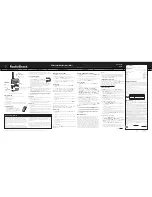
Gill Instruments Ltd
_____________________________________________________________________________________________________________
________________________________________________________________________________________________
MaxiMet
Page 25
Issue 1
Doc. No. 1957-PS-000x
March 2015
Mounting Tube/Pole
A tube 1.75 inches (44.45mm) Outside Diameter x 3mm wall thickness is recommended (see
figure on the next page).
Note it is important that the correct diameter tube is used to prevent
damage to the MaxiMet lower moulding when tightening the screws.
The support tube requires three 3 equally spaced holes, tapped M5, 7.5mm from the top of the
tube. Pass the cable (fitted with the 9 way Clipper plug) through the tube.
Note:
the customer must fit appropriate strain relief to the cable.
Connect the plug by twisting it whilst pushing it gently into the socket on the MaxiMet. When it
locates, twist the outer sleeve clockwise to connect and lock the plug.
Fix the MaxiMet to the tube using the 3 stainless steel screws provided. (Maximum mounting
screw torque 4 Nm.)
For hostile environments, you should select a material suitable for the intended environment. For
example, stainless steel 316 for marine use.
For non-hostile environments an Aluminium tube can be used.
NOTE:
An optional 0.5 Metre Aluminium mounting tube is available from Gill Instruments (Part
1405-30-056). This tube is predrilled and tapped with 3 holes to match with those on the base of
the MaxiMet unit (3 mating screws and washers supplied with the MaxiMet mounting kit).
Alignment
The MaxiMet anemometer should be set to point North (or to another known reference direction),
using the North Pointers, which are identified on the instrument figure on the next page.
If the MaxiMet Compass output is enabled by using MetSet then a direct magnetic north compass
reading can be used to set MaxiMet north markers to north.
Otherwise MaxiMet need not be aligned precisely if the compass Corrected Direction (CDIR)
readings are to be used.
















































